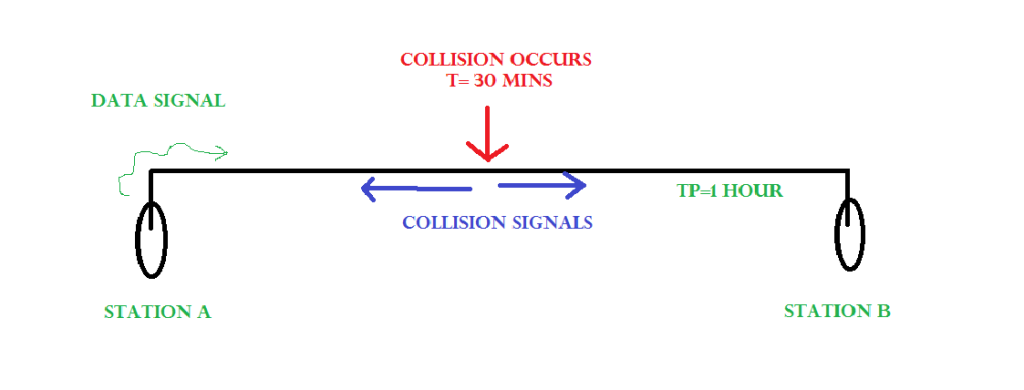Preparing for the GATE CS/IT 2025 exam requires a deep understanding of networking concepts, and CSMA/CD (Carrier Sense Multiple Access with Collision Detection) is a core topic. Here, we’ll explore 14 essential questions that will strengthen your grasp of CSMA/CD and related networking principles, complete with explanations, solutions, and strategies to tackle such questions efficiently.
Table of Contents
What is CSMA/CD and Its Role in Networking?
CSMA/CD, primarily used in Ethernet networks, ensures effective communication by managing data collisions. This protocol is essential for understanding and solving networking problems in the GATE CS/IT exam, particularly those involving collision handling, throughput, and propagation delay.

Key Concepts of CSMA/CD Explained
- Carrier Sense: Devices listen to the medium before transmitting.
- Multiple Access: Multiple devices share the communication medium.
- Collision Detection: If a collision occurs, devices stop transmitting, wait for a random backoff time, and retry.
For instance, in an Ethernet network, if two devices attempt to send data simultaneously, the collision is detected, and retransmission is attempted after a random delay.
Also Read: Best GATE Coaching Centre in India: Your Gateway to Success
14 Must-Know CSMA/CD Questions for GATE CS/IT
Q1: Fifty stations on a pure ALOHA network share a 1 Mbps channel. If frames are 2000 bits long, find throughput (in Kbps) if each station is sending 20 frames per second.
Solution:
The total frame rate: 50×20=100050 \times 20 = 1000 frames per second.
The average frame transmission time: 20001×106=2 ms\frac{2000}{1 \times 10^6} = 2 \, ms.
Throughput for pure ALOHA: S=G⋅e−2GS = G \cdot e^{-2G}, where G=Frame Rate⋅Transmission TimeChannel Bandwidth=2G = \frac{\text{Frame Rate} \cdot \text{Transmission Time}}{\text{Channel Bandwidth}} = 2.
Using G=2G = 2:
S=2⋅e−4≈0.036 Mbps=36 Kbps.S = 2 \cdot e^{-4} \approx 0.036 \, Mbps = 36 \, Kbps.
Q2: A pure ALOHA network transmits 200-bit frames on a shared channel of 200 kbps. What is the throughput (in frames per second) if the system (all stations together) produces 1000 frames per second?
Solution:
Frame transmission time: 200200×103=1 ms\frac{200}{200 \times 10^3} = 1 \, ms.
Throughput: S=G⋅e−2GS = G \cdot e^{-2G}, G=Frame Rate⋅Transmission Time=1G = \text{Frame Rate} \cdot \text{Transmission Time} = 1.
Using G=1G = 1:
S=1⋅e−2≈0.135×1000=135 frames/second.S = 1 \cdot e^{-2} \approx 0.135 \times 1000 = 135 \, \text{frames/second.}
Also Read: Online Coaching for GATE: Tips to Stay Motivated and Focused
Q3: A slotted ALOHA network transmits 200-bit frames on a shared channel of 200 kbps. What is the throughput (in frames per second) if the system (all stations together) produces 1000 frames per second?
Solution:
For slotted ALOHA, throughput: S=G⋅e−GS = G \cdot e^{-G}, G=1G = 1.
Using G=1G = 1:
S=1⋅e−1≈0.368×1000=368 frames/second.S = 1 \cdot e^{-1} \approx 0.368 \times 1000 = 368 \, \text{frames/second.}
Q4: A group of N stations shares a 100-Kbps pure ALOHA channel. Each station outputs a 128-bytes frame on an average of once every 64 seconds. What is the maximum value of N?
Solution:
Frame size: 128×8=1024 bits.128 \times 8 = 1024 \, \text{bits.}
Average frame rate per station: 164 frames/second.\frac{1}{64} \, \text{frames/second.}
Channel utilization for pure ALOHA: N⋅164⋅1024100×103≤0.18.N \cdot \frac{1}{64} \cdot \frac{1024}{100 \times 10^3} \leq 0.18.
Solving for NN:
N≤0.18×64×100×1031024≈1125.N \leq \frac{0.18 \times 64 \times 100 \times 10^3}{1024} \approx 1125.
Q5: 2000 airline reservation stations are competing for the use of a single slotted ALOHA channel. The average station makes 18 requests per hour. A slot is 50 μsec. What is the approximate total channel load (in %)?
Solution:
Request rate per station: 183600 requests/second.\frac{18}{3600} \, \text{requests/second.}
Total request rate: 2000×183600=10 requests/second.2000 \times \frac{18}{3600} = 10 \, \text{requests/second.}
Channel load: G=Request Rate⋅Slot Time×100=10×50×10−6×100=0.5%.G = \text{Request Rate} \cdot \text{Slot Time} \times 100 = 10 \times 50 \times 10^{-6} \times 100 = 0.5\%.
Also Read: Best Online GATE Coaching for CSE: A Comprehensive Guide
Other Questions to Explore
Q6: Which of the following statements are true about CSMA/CD?
Explanation provided based on options.
Q7: Concerning computer networks, which of the following statements are false?
Detailed explanation based on options.
Q8: Which statement is true about the CSMA/CD access method?
Detailed explanation provided.
Q9: How long does the Ethernet adapter wait for K = 100?
Solution: Time = K⋅Slot Time=100⋅51.2 μs=5.12 ms.K \cdot \text{Slot Time} = 100 \cdot 51.2 \, \mu s = 5.12 \, ms.
Q10 to Q14: Advanced Questions
These questions involve propagation delay, collision detection, and throughput analysis, solved with detailed calculations.
Time-Saving Tips for Networking Questions in GATE CS/IT
Master Key Formulas
Memorize formulas like propagation delay, transmission delay, and throughput efficiency.
Practice Numerical Problems
GATE frequently tests your ability to apply CSMA/CD concepts to numerical problems. Solve at least 20 varied questions from this topic.
Understand Ethernet Frame Structure
Knowing the components like preamble, destination address, and CRC can save time on basic questions.
How to Tackle Tricky CSMA/CD Questions in GATE 2025
Understand the Context
Analyze whether the question focuses on theoretical concepts, numerical calculations, or real-world scenarios.
Break Down Complex Questions
For questions involving multiple steps, like calculating throughput or propagation delay, write down each step clearly to avoid confusion.
Practice Mock Tests
Attempting mock tests under timed conditions builds confidence and improves speed.
Conclusion
These 14 CSMA/CD questions for GATE CS/IT cover critical concepts and problem-solving techniques that can help you ace the networking section. Regular practice and understanding of these principles will not only boost your confidence but also ensure success in the GATE CS/IT 2025 exam.